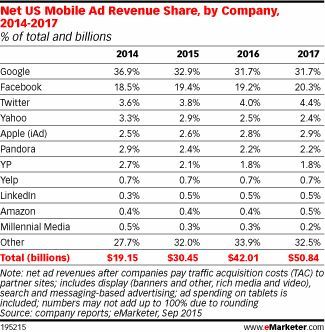The seismic shift you felt recently was caused by Google AdWords undergoing some fundamental changes. Some are positive, with new features coming to AdWords that promise to save you time and improve results. Others are more worrisome, with big changes in Google’s algorithms impacting search results in new ways, forcing marketers to adapt. In both cases, marketers are well advised to pay close attention, since whatever Google does has huge impact across the entertainment and software industries.
Google has been the king of desktop searches, but increasingly the company is shifting to mobile. As Google noted in its Inside AdWords blog, “Every year, there are trillions of searches on Google and over half of those searches happen on mobile. And across the millions of websites using Google Analytics today, we’re seeing more than half of all web traffic now coming from smartphones and tablets.” Therefore, Google has rolled out a number of changes in recognition of this increasingly mobile-first world. Google’s the strong leader in online advertising, and it intends to remain that way despite the challenges from Facebook and others.
Google now makes its Universal App Campaigns (UACs), first introduced for Android apps, available on iOS. UACs allow app developers to quickly and easily create and launch mobile app install campaigns, with the the interface merely picking up some details about the app then generating creative assets that are sent off to run. Those campaigns delivered more than two billion downloads for advertisers across Google Search, Google Play, YouTube and the Google Display Network. Google has also reformatted its text ads to work equally well on mobile or desktop, and later this year will provide expanded text ads that will allow more prominent headlines, longer description lines and let you customize your URL path.
Another change Google is rolling out is what the company dubs responsive ads for display, which adapt to the format and aesthetics of sites on the Google Display Network. These campaigns are created dynamically once you give them a few pieces of information, grabbing assets from Google Play with images and text you provide. The ads created this way match the look and feel of content users are browsing. This comes along with Google allowing access to cross-exchange inventory, which will include more websites and apps worldwide. Also, Google is allowing you to optimize campaigns around in-app events, not just around installs. (Many mobile ad networks already do this, of course, but it’s useful to have in Google, especially with UACs.)
Google’s also increasing ad exposure in YouTube and is experimenting with a new ad unit in Gmail. Now, this shouldn’t be taken as a sign that Google’s ad revenues need boosting—the opposite is true, with Google’s ad revenues climbing at a rather impressive rate. The company booked $19.08 billion in ad revenue during Q4 2015, up 18 percent over last year, while cost-per-click (CPCs) have been flat or declining since Q3 2014. YouTube, in particular, is showing impressive growth, with overall revenues for 2016 projected to hit $12.8 billion, up from $8.5 billion last year. Certainly some of that is due to the subscription revenues from YouTube Red, but there’s plenty of extra ad revenue in there, too.
There’s also a new unified bid structure allowing you to set individual bid adjustments for each device type, between mobile, desktop and tablet. Google will give you wider range to adjust bids up to 900 percent of the base value. Eventually you’ll be able to manage bids for all devices in a single place and anchor a base keyword bid to the device most valuable to you, and then adjust that bid up or down for other devices. It’s a recognition of the multiple-device world we live in, and the fact that not all products are searched for and purchased at the same rate through different device types.
Perhaps more important than these AdWords changes are the changes that Google has announced to how they’re searching and ranking websites. For the first time, Google has revealed the top-three ranking signals that their algorithm uses. In the past, Google has noted that there are more than 200 parameters the algorithm uses, but never before has Google revealed the top parameters. Last year Google announced their article intelligence system, RankBrain, was their number three ranking signal. This year at a Google Q&A in late March, Google Ireland’s search quality senior strategist Andrey Lipattsev revealed the other two factors: links and content. Queried further about their relative importance, Lipattsev said there was “no order” to their importance, meaning all three are at the top.
The message from Google has been clear: Don’t get caught with old content on your site, or risk heading to the bottom of the rankings. Google’s been pushing this for a while, trying to weed out content farms, companies with static websites and even a few giants like eBay have been seeing their rankings drop.
Now, though, some of the biggest publishing brands in the industry have watched their rankings drop with the changes to Google’s algorithm. There have been some massive hits at some major players—TheAtlantic.com lost 80 percent of its SEO visibility, and Wired.com lost 65 percent of its mobile visibility. Even Apple dropped 63 percent, though, it’s not a publishing company. These are not trivial differences.
There are signs that branded search results are getting redone, with even Google’s own Gmail seeing its mobile visibility lowered. There was some speculation that it was only mobile, but the data showed that desktop sites had taken similar drops. “Google was serious about ensuring companies migrated to the focus on new and differentiated content rather than relying on existing content to maintain its search engine rank,” said Shai Aharony, founder of Reboot Online.
The message from Google is that content marketing needs to be fresh, not just repurposed content with a few minor changes. Google’s algorithm won’t be fooled by some cosmetic changes. Marketers need to think about more in-depth strategies for content marketing, and include social media content, links and apps in the mix as well. That may mean conducting research, finding customer stories to tell, or finding ways to have customers help in generating more content. Marketers, start your content engines! You can’t take your search position for granted any more if your content is not being refreshed regularly.

